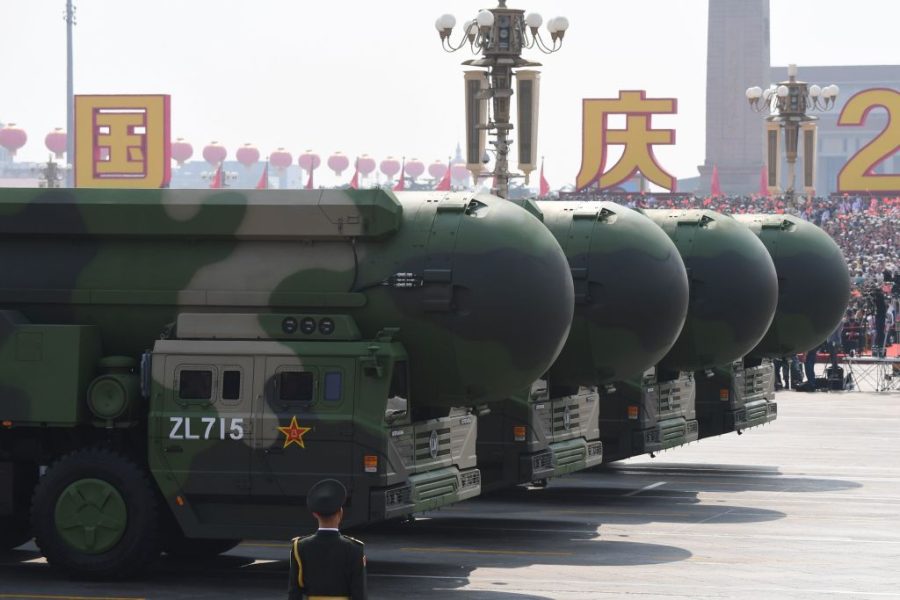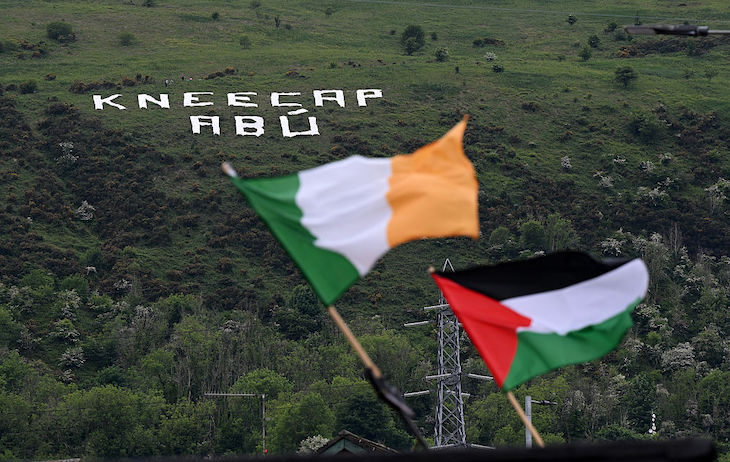China is growing its nuclear arsenal at a faster pace than any other country on the planet, according to new figures from the Stockholm International Peace Research Institute (SIPRI). It estimates that Beijing now has more than 600 nuclear warheads and is adding about 100 per year to its stockpile. That means that by 2035, it will have more than 1,500 warheads, still only a third of the arsenal of each of Russia and the US, but nevertheless an enormous increase and a marked shift away from its proclaimed policy of ‘minimum deterrence’.
To facilitate this expanding arsenal, China is building fields of new missile silos in its western desert regions. The Federation of American Scientists, which identified the silos via satellite imagery, has described them as ‘the most significant expansion of the Chinese nuclear arsenal ever.’
China is engaged in one of the largest military build-ups ever seen during peacetime
The Pentagon believes China is planning to quadruple its nuclear weapons stockpile by 2030, and its fears have been further heightened by People’s Liberation Army (PLA) tests of nuclear-capable hypersonic weapons designed to evade America’s nuclear defences. One test involved the launch of a rocket into space, which circled the globe before releasing into orbit a highly manoeuvrable hypersonic glider. The nuclear-capable glider – which has been likened to a weaponised space shuttle – had the ability to surf along the earth’s atmosphere before powering down to its target at up to five times the speed of sound (hence the hypersonic). Hypersonic weapons are far more difficult to detect and destroy than traditional ballistic missiles.
This week, China’s foreign ministry spokesperson insisted: ‘China has always adhered to the nuclear strategy of self-defence, always maintained its nuclear forces at the minimum level required for national security, and has not participated in the arms race.’ This claim is almost as hackneyed as that of China’s ‘peaceful rise’, but understanding China’s evolving military doctrine is especially challenging because Beijing ’is refusing to take part in nuclear arms control talks.
China last year suspended talks over arms control and nuclear proliferation with the US ostensibly because of American arms sales to Taiwan. However, Beijing has always been a reluctant participant. It is engaged in one of the largest military build-ups ever seen during peacetime, yet there are none of the protocols and little of the depth of mutual knowledge about capabilities and intentions that existed and provided a level of stability during the last Cold War with the Soviet Union.
Western strategists believe that one aim of the rapid nuclear build-up is to deter America from coming to the defence of Taiwan, which China claims as its own, and which it has repeatedly threatened to invade. The thinly disguised message to Washington is that America is deluding itself if it thinks a conflict over Taiwan could be contained to the immediate area and not endanger the American homeland.
Trying to make sense of China’s military doctrine is made all the more challenging by an ongoing purge at the top of the PLA and a heightened level of intrigue surrounding both the army and the Chinese Communist party (CCP). Earlier this year, General He Weidong, the number-two officer in the PLA and a member of the CCP’s 24-strong politburo, was removed from his post. This followed the disappearance of Miao Hua, a navy admiral and one of six members (along with He) of the party’s powerful central military commission, which is chaired by President Xi Jinping.
Miao was also head of the PLA’s political works department – charged with ensuring CCP control over the military. The PLA is a party organisation, and in the military pecking order, Miao was regarded as more powerful even than defence minister Dong Jun. Rumours have also swirled that Dong himself has been under investigation. He appears to have survived, at least for now, but if deposed, he would be the third successive defence minister to face corruption charges.
China’s rocket force, the most secretive and sensitive branch of China’s military responsible for overseeing in part all those shiny new nukes, has also been the target of an extensive purge. Those targeted included the two heads of the force. Among others purged have been a navy commander responsible for the South China Sea and several others responsible for procuring equipment – long a notoriously corrupt part of the military.
When Xi came to power in 2012, he pledged to clean up the PLA, which ran a business empire so big that preparing for war often appeared to be a secondary concern. In spite (or possibly because of) Xi’s efforts, the graft only seems to have got worse – though it should be noted that ‘corruption’ is frequently used as a catch-all and a pretext for the removal of those considered insufficiently loyal to the leader. Because many of those now being targeted include Xi’s hand-picked officials, it will inevitably be seen as an indictment of his abilities and judgement.
This week’s figures from SIPRI certainly confirm the worrying extent of China’s nuclear ambitions. For the country’s top brass charged with wielding these fearsome weapons, however, navigating the corridors of power at the pinnacle of Xi Jinping’s capricious CCP is proving considerably more dangerous than the battlefield.








Comments